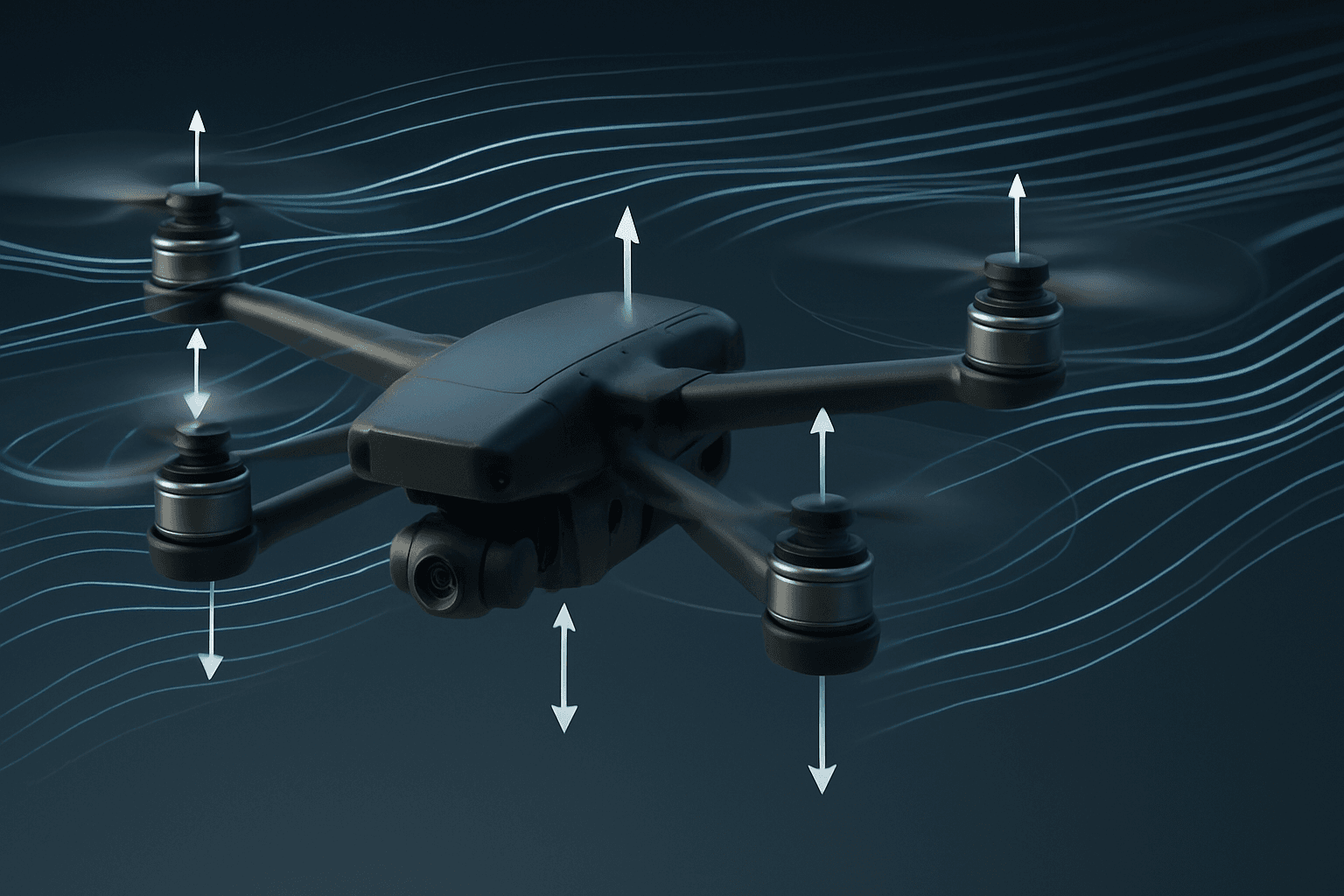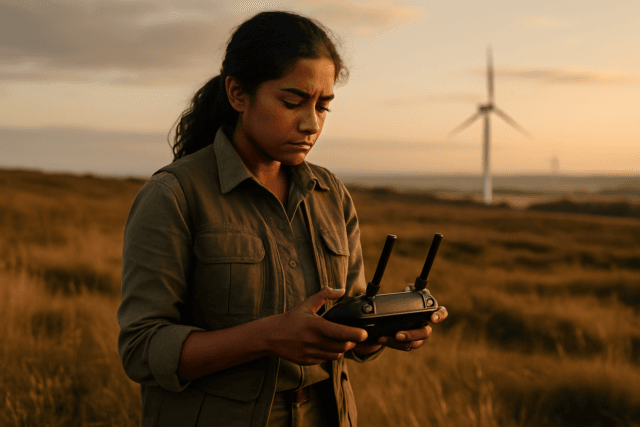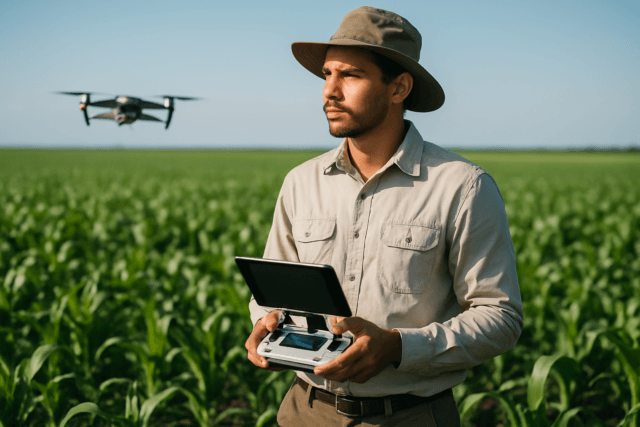Drones, also known as unmanned aerial vehicles (UAVs), have become increasingly popular for various applications, from aerial photography and surveying to search and rescue missions and even package delivery. The ability of these machines to fly and maneuver depends on a complex interplay of physics, engineering, and aerodynamics. Understanding the principles of drone aerodynamics is crucial for optimizing their design, enhancing their performance, and ensuring their safe operation.
Decoding Drone Flight: The Core Aerodynamic Principles
Several fundamental principles govern how aerodynamic a drone is, influencing its design and enabling stable and efficient flight. These include lift, thrust, drag, weight, stability, control, and the effects of wind.
The Four Forces of Flight
Drones must master four fundamental forces to ascend and maneuver effectively: lift, weight, thrust, and drag.
- Lift: Lift is the force that opposes the drone’s weight, allowing it to ascend and stay aloft. It is generated by the дви shape and angle of the drone’s wings or the spinning of its rotors, which create a difference in air pressure above and below the surface. Air flowing over the wing or rotor creates a lower pressure area above and a higher pressure area below, resulting in an upward force.
- Weight: Weight is the force of gravity pulling the drone down towards the Earth. It is directly proportional to the drone’s mass. Lift must overcome weight for stable flight.
- Thrust: Thrust is the force that propels the drone forward, overcoming drag. It is generated by the drone’s propellers or rotors, which push air backward. The spinning propellers create a forward force.
- Drag: Drag is the aerodynamic resistance the drone encounters as it moves through the air. It acts opposite to the direction of motion, slowing the drone down. Minimizing drag is crucial for enhancing efficiency.
Achieving Stability and Control
Achieving and maintaining stability is crucial for effective drone operation. This involves a delicate balance of design, weight distribution, and real-time control adjustments.
- Design: Aerodynamic shapes and balanced weight distribution aid in natural stability.
- Control Systems: Modern drones incorporate advanced gyroscopes and accelerometers to monitor and adjust their position, orientation, and motion.
- Control Surfaces: Drones utilize control surfaces to adjust angular velocity and achieve flight stability. By precisely controlling it, drones can maintain their position or change direction.
The Impact of Wind
Wind can significantly affect drone operations, influencing trajectory and battery efficiency.
- Headwinds: Headwinds increase drag and reduce speed, demanding more power and reducing efficiency.
- Tailwinds: Tailwinds can boost speed but may compromise control and stability.
- Crosswinds: Crosswinds introduce lateral forces that can cause drift and require adjustments to maintain the intended flight path.
Drone Types and Aerodynamic Considerations
Drones come in various configurations, each with unique aerodynamic considerations. The two common styles of drone design are rotary drones and fixed-wing drones.
Rotary-Wing Drones
Rotary-wing drones, such as quadcopters, use multiple rotors to generate lift. Each rotor consists of a motor and a propeller. When the propellers spin, they create a downward thrust by pushing air downwards, which in turn generates an upward lift force, allowing the drone to hover, ascend, or descend.
- Vertical Takeoff and Landing (VTOL): Rotary-wing drones offer excellent vertical takeoff and landing capabilities.
- Maneuverability: They can maneuver easily in tight spaces.
- Hovering: They can hover in place, making them suitable for tasks like aerial photography and inspection.
- Control: Control in drones is achieved through varying the speed of the rotors. Roll is controlled by adjusting the speed of rotors on opposite sides. Pitch is managed by altering the speed between front and back rotors. Yaw is adjusted by changing the relative speed of rotors spinning in opposite directions.
- Challenges: Rotary-wing drones are generally less energy-efficient than fixed-wing drones, limiting their flight time.
Fixed-Wing Drones
Fixed-wing drones operate more like traditional airplanes, using fixed wings to generate lift. They require forward motion, provided by a propeller or jet engine, to create airflow over the wings and generate lift.
- Efficiency: Fixed-wing drones are significantly more efficient than rotary-wing drones, enabling longer flight times.
- Range: They are ideal for long distances and high-altitude flights.
- Speed: They can achieve higher speeds than rotary-wing drones.
- Challenges: Fixed-wing drones require a runway or launching mechanism for takeoff and landing. They cannot hover in place and have limited maneuverability in tight spaces.
Hybrid Drones
Hybrid drones integrate the VTOL capabilities of multirotors with the aerodynamic efficiency and extended range of fixed-wing aircraft. This fusion aims to surmount the limitations inherent in conventional drone designs, offering a versatile platform capable of operating in diverse environments.
Key Aerodynamic Considerations in Drone Design
Several key aerodynamic considerations play a crucial role in drone design, influencing their performance, stability, and efficiency.
Airfoil Design
Airfoils are the cross-sectional shape of the wings. The design of the airfoil significantly affects the lift and drag characteristics of the wing.
- Lift Generation: Airfoils generate lift by displacing the airflow, inducing a net curvature as air is directed downwards. Air traveling over the upper surface accelerates, while air along the lower surface slows down. This creates an area of low pressure above the wing and high pressure below the wing, generating a lift force.
- Airfoil Selection: When selecting an airfoil, it’s important to consider the drone’s mission and flight characteristics. Asymmetric profiles can sometimes have a narrow efficient operating window and drastic changes in the lift curve, making the drone difficult to control. Symmetric profiles are preferable for flaps, wings, and rudders that need to generate both positive and negative lift.
- Airfoil Series: NACA four-digit airfoils are parameterized using four numbers. The first number represents the maximum camber of the airfoil as a percentage of the chord, the second represents where the maximum camber occurs along the chord, and the last two give the thickness of the airfoil as a percentage of the chord.
Propeller Design
Propellers are crucial for generating thrust in both rotary-wing and fixed-wing drones. The design of the propeller significantly affects the drone’s thrust, power consumption, and overall efficiency.
- Blade Geometry: The shape and twist of the propeller blades influence their aerodynamic performance. Propellers are designed using numerical formulas to optimize their efficiency. High lift, low drag airfoils are well-suited for low Reynolds numbers.
- Number of Blades: The number of blades affects the thrust and efficiency of the propeller.
- Propeller Material: Low-weight and rigid materials are used to minimize inertia and maximize responsiveness.
- Fuselage Blanketing: Fuselage blanketing can have a significantly detrimental impact on propeller performance. It is recommended that the hub section of the propeller be redesigned to mitigate drag and propulsive losses resulting from reduced momentum in the blanketed region of the propeller.
Wingtip Devices
Wingtip devices, such as winglets, are often incorporated into wing designs to improve aerodynamic efficiency. These devices reduce wingtip vortices, which are swirling airflows that create drag.
- Lift-to-Drag Ratio: Wingtip devices can significantly improve the lift-to-drag ratio, enhancing the drone’s range and endurance.
Computational Fluid Dynamics (CFD)
Computational Fluid Dynamics (CFD) is a crucial tool in the study of drone aerodynamics for modeling airflow patterns around the drone’s body and propellers. Aerodynamic forces including lift, drag, and thrust may be precisely modeled using CFD, which is essential for the drone’s stability and mobility. Engineers can efficiently optimize drone designs using multiple levels of simulation fidelity, allowing drones to fly longer and maintain stable flight maneuvers.
- AirShaper: AirShaper is a cloud-based platform that automates the entire aerodynamics simulation process from a 3D model to a finished CFD simulation.
- Optimization: CFD can be used to optimize the angle of attack for drone wings to increase lift-to-drag ratios.
Optimizing Drone Aerodynamics for Enhanced Performance
Optimizing the aerodynamics of drones is crucial for improving their flight performance, extending their flight time, and increasing their payload capacity. Several strategies can be employed to achieve this goal.
Minimizing Drag
Minimizing drag is essential for improving drone efficiency and maximizing flight time.
- Streamlined Fuselage: Optimizing the fuselage design to reduce drag and improve airflow around the drone enhances efficiency and stability during flight.
- Smooth Surfaces: Minimizing surface roughness and protuberances reduces friction drag.
- Optimal Payload Placement: Optimal payload placement, closer to the center of gravity, facilitates a balanced weight distribution and minimizes the strain on thrust requirements.
Maximizing Lift
Maximizing lift is crucial for enabling drones to carry heavier payloads and operate at higher altitudes.
- Airfoil Selection: Selecting airfoils with high lift coefficients maximizes lift generation.
- Angle of Attack Control: Controlling the angle of attack within the optimal range maximizes lift while minimizing drag.
Enhancing Thrust
Enhancing thrust improves the drone’s ability to accelerate, climb, and maneuver.
- Propeller Design: Optimizing propeller design to maximize thrust generation while minimizing power consumption enhances efficiency.
- Motor Selection: Selecting powerful and efficient motors ensures adequate thrust for various flight conditions.
Balancing Stability and Control
Balancing stability and control is essential for ensuring safe and reliable drone operation.
- Aerodynamic Design: Incorporating aerodynamic features that enhance stability, such as winglets and properly sized control surfaces, improves handling characteristics.
- Flight Control Systems: Implementing advanced flight control systems that provide precise control over the drone’s attitude and trajectory enhances maneuverability and stability.
The Future of Drone Aerodynamics
The field of drone aerodynamics is constantly evolving, with ongoing research and development efforts focused on improving drone performance, efficiency, and capabilities.
- Advanced Airfoil Designs: Researchers are exploring novel airfoil designs that can generate higher lift, lower drag, and improved stall characteristics.
- Innovative Propulsion Systems: New propulsion systems, such as ducted fans and electric ducted fans, are being developed to enhance thrust, reduce noise, and improve efficiency.
- Adaptive Wing Technology: Adaptive wing technology, which allows the wing shape to change during flight, is being explored to optimize performance for different flight conditions.
- Urban Air Mobility (UAM): Aerodynamic principles will be pivotal in UAM, envisioning a future where advanced aircraft, such as electric vertical take-off and landing (eVTOL) vehicles, provide efficient and sustainable transportation solutions in urban areas.
By understanding and applying the principles of drone aerodynamics, engineers and researchers can continue to push the boundaries of what’s possible in aerial technology, paving the way for new and innovative applications of drones in various fields.





